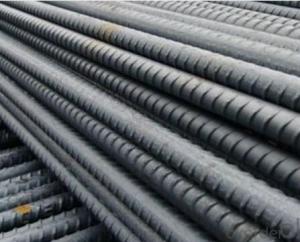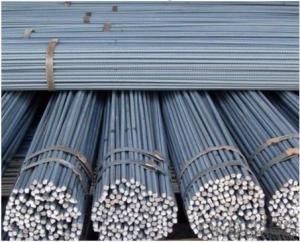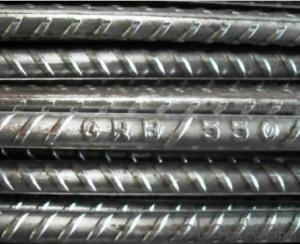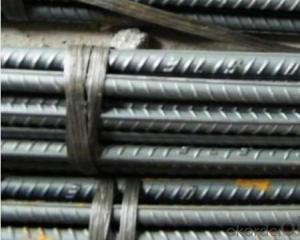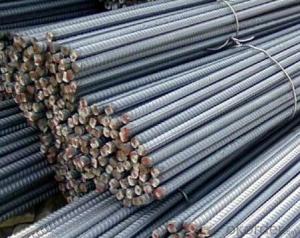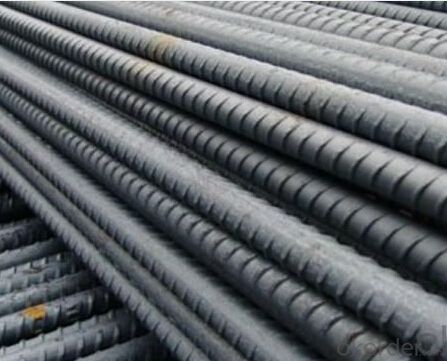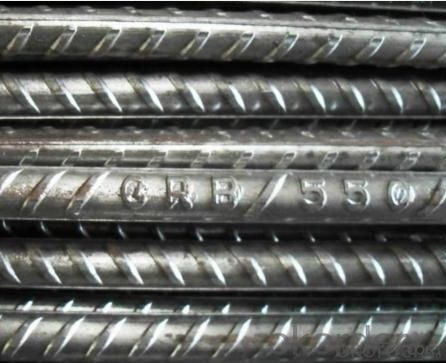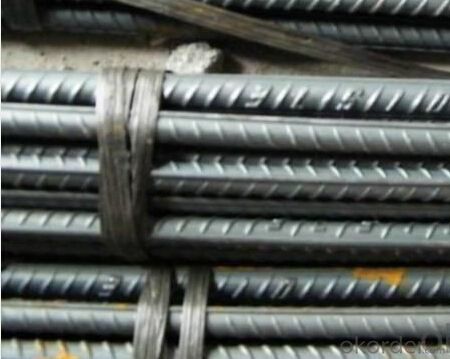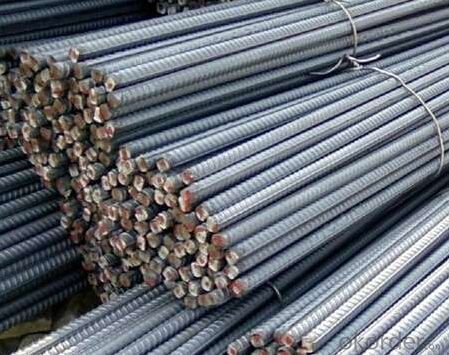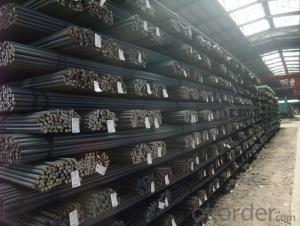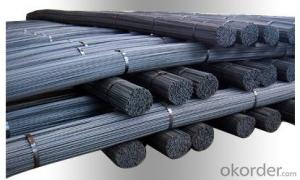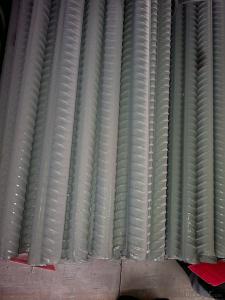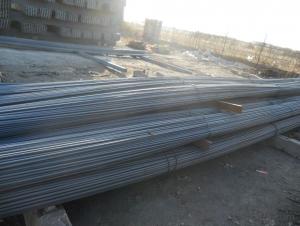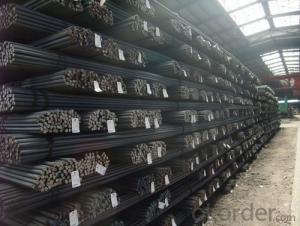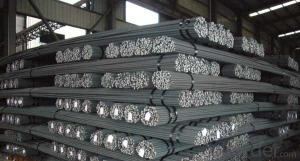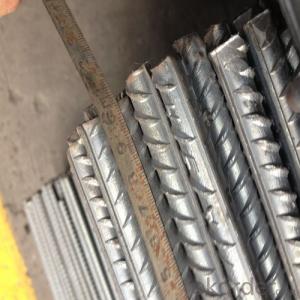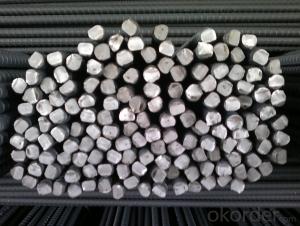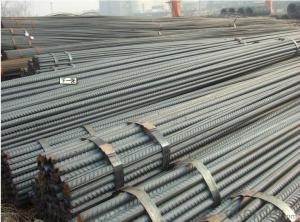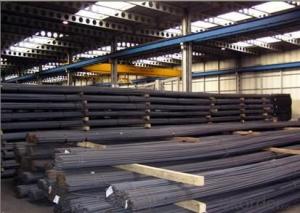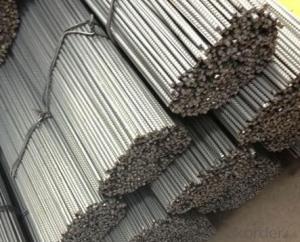Deformed Steel Bar with Standard ASTM A615
- Loading Port:
- Tianjin
- Payment Terms:
- TT OR LC
- Min Order Qty:
- 100 m.t.
- Supply Capability:
- 5000 m.t./month
OKorder Service Pledge
OKorder Financial Service
You Might Also Like
Product Description:
OKorder is offering Deformed Steel Bar with Standard ASTM A615 at great prices with worldwide shipping. Our supplier is a world-class manufacturer of steel, with our products utilized the world over. OKorder annually supplies products to European, North American and Asian markets. We provide quotations within 24 hours of receiving an inquiry and guarantee competitive prices.
Product Applications:
Deformed Steel Bar with Standard ASTM A615 are ideal for structural applications and are widely used in the construction of buildings and bridges, and the manufacturing, petrochemical, and transportation industries.
Product Advantages:
OKorder's Deformed Steel Bar with Standard ASTM A615 are durable, strong, and resist corrosion.
Main Product Features:
· Premium quality
· Prompt delivery & seaworthy packing (30 days after receiving deposit)
· Corrosion resistance
· Can be recycled and reused
· Mill test certification
· Professional Service
· Competitive pricing
Specifications of Deformed Steel Bar with Standard ASTM A615:
Standard | GB UK USA | HRB335 HRB400 HRB500 G460B, B500A, B500B,B500C GR40, GR60 | |
Diameter | 6mm,8mm,10mm,12mm,14mm,16mm,18mm,20mm, 22mm,25mm,28mm,32mm,36mm,40mm,50mm | ||
Length | 6M, 9M,12M or as required | ||
Packing | Export standard packing: wrapped by wire rod in bundles | ||
Each bundle weight | 2-3MT, or as required | ||
Trade terms | FOB, CFR, CIF | ||
Payment terms | TT payment in advance or Irrevocable LC at sight. | ||
Delivery Detail | within 45 days after received advanced payment or LC. | ||
Brand name | DRAGON | ||
Theoretical weight and section area of each diameter as below for your information:
Diameter(mm) | Section area (mm²) | Mass(kg/m) | Weight of 12m (kg) | Pcs/ton |
6 | 28.27 | 0.222 | 2.664 | 375.38 |
8 | 50.27 | 0.395 | 4.74 | 210.97 |
10 | 78.54 | 0.617 | 7.404 | 135.06 |
12 | 113.1 | 0.888 | 10.656 | 93.84 |
14 | 153.9 | 1.21 | 14.52 | 68.87 |
16 | 201.1 | 1.58 | 18.96 | 52.74 |
18 | 254.5 | 2.00 | 24 | 41.67 |
20 | 314.2 | 2.47 | 29.64 | 33.74 |
22 | 380.1 | 2.98 | 35.76 | 27.96 |
25 | 490.9 | 3.85 | 46.2 | 21.65 |
28 | 615.8 | 4.83 | 57.96 | 17.25 |
32 | 804.2 | 6.31 | 75.72 | 13.21 |
36 | 1018 | 7.99 | 98.88 | 10.43 |
40 | 1257 | 9.87 | 118.44 | 8.44 |
50 | 1964 | 15.42 | 185.04 | 5.40 |
Chemical Composition: (Please kindly find our chemistry of our material based on JIS as below for your information)
JISG3112 SD390 | Chemical Composition | ||||
C | Mn | Si | S | P | |
0.22 | 1.38 | 0.4 | 0.014 | 0.022 | |
Physical capability | |||||
Yield Strength(N/cm²) | Tensile Strength(N/cm²) | Elongation (%) | |||
620 | ≥400 | 21 | |||
The production process of Deformed Steel Bar with Standard ASTM A615
1-Waling beam furnace
2-Roughing rolling group
3-Intermediate rolling train
4-Finishing rolling group
5-Water-cooling device
6-Walking beam cooler
7-Finishing equipment(including the cold scale shear,short feet collection system,
automatic counting device,bundling machine, collect bench)
Usage and Applications of Deformed Steel Bar with Standard ASTM A615:
Deformed bar is widely used in buildings, bridges, roads and other engineering construction. Big to highways, railways, bridges, culverts, tunnels, public facilities such as flood control, dam, small to housing construction, beam, column, wall and the foundation of the plate, deformed bar is an integral structure material. With the development of world economy and the vigorous development of infrastructure construction, real estate, the demand for deformed bar will be larger and larger..
Packaging & Delivery of Deformed Steel Bar with Standard ASTM A615:
Packaging Detail: products are packed in bundle and then shipped by container or bulk vessel, deformed bar is usually naked strapping delivery, when storing, please pay attention to moisture proof. The performance of rust will produce adverse effect.
Price: Keep lower operating costs so as to offer competitive price for our clients
FAQ:
Q1: Why buy Materials & Equipment from OKorder.com?
A1: All products offered byOKorder.com are carefully selected from China's most reliable manufacturing enterprises. Through its ISO certifications, OKorder.com adheres to the highest standards and a commitment to supply chain safety and customer satisfaction.
Q2: How do we guarantee the quality of our products?
A2: We have established an advanced quality management system which conducts strict quality tests at every step, from raw materials to the final product. At the same time, we provide extensive follow-up service assurances as required.
Q3: How soon can we receive the product after purchase?
A3: Within three days of placing an order, we will begin production. The specific shipping date is dependent upon international and government factors, but is typically 7 to 10 workdays.
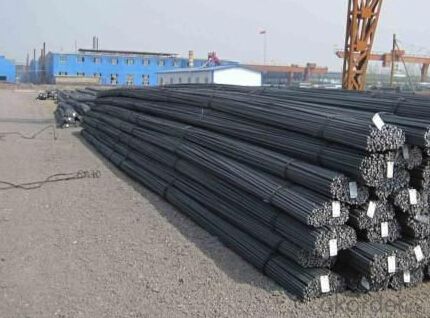
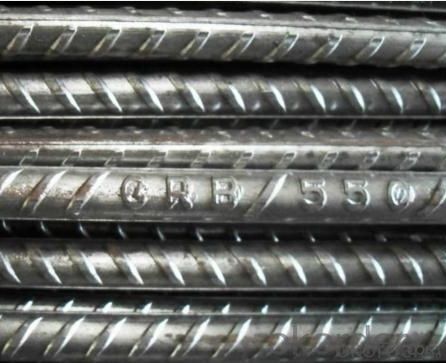
- Q: What is the specific concept of thread steel through water and what is the difference?
- The principle of water cooling technology to produce rebar is that austenite can be strongly deformed in the process of continuous rolling in the recrystallization zone, resulting in very fine, strongly hardened austenite grains with a lot of defects. With the high speed of cooling on the enhanced cooling of austenite, in a very short period of time, generally not more than 0.5s, is rapidly cooled to near the phase transition temperature, inhibit the growth of austenite grain, try to keep the hardening state of austenite. When the temperature is near the phase transition point, the fine hardening austenite grains are transformed into ferrite with proper grain size under proper air cooling conditions.
- Q: How do steel rebars affect the overall lifespan of a structure?
- Steel rebars play a crucial role in enhancing the overall lifespan of a structure. The addition of rebars in reinforced concrete significantly improves the strength, durability, and structural integrity of the building. Firstly, steel rebars provide reinforcement to the concrete, making it capable of withstanding heavy loads and stresses. Concrete itself is strong in compression but lacks tensile strength. By incorporating rebars, the concrete is able to resist tension forces, preventing cracks and failures that could compromise the structure's longevity. Furthermore, steel rebars act as a barrier against corrosion. Concrete is a porous material, and when water and moisture penetrate its surface, it can reach the embedded steel, leading to rust and subsequent weakening of the structure. However, rebars are made of corrosion-resistant materials, such as stainless steel or epoxy-coated steel, which protect them from corrosion, ensuring the longevity of the structure. In addition, steel rebars enhance the overall stability and load-bearing capacity of the structure. By reinforcing critical areas, such as beams, columns, and foundation, rebars increase the structure's ability to resist seismic forces, wind loads, and other external pressures. This reinforcement significantly reduces the risk of structural failure and improves the structural lifespan. Moreover, steel rebars allow for flexibility and adaptability in design. Their availability in various sizes and shapes enables engineers to customize the reinforcement according to the specific needs of the structure. This flexibility ensures that the structure is optimized for maximum strength and durability, further extending its lifespan. In conclusion, steel rebars play a vital role in increasing the overall lifespan of a structure. Their ability to reinforce concrete, resist corrosion, enhance stability, and provide design flexibility ensures that the building can withstand various loads and environmental conditions, minimizing the risk of premature failure and ensuring the longevity of the structure.
- Q: What are the considerations for using epoxy-coated steel rebars?
- When using epoxy-coated steel rebars, there are several considerations to keep in mind. Firstly, it is important to ensure that the coating is properly applied and has adhered well to the rebar surface to provide effective protection against corrosion. Secondly, the epoxy coating should be resistant to chemicals commonly found in the construction environment. Additionally, the handling and storage of epoxy-coated rebars should be done with care to avoid any damage to the coating. It is also crucial to follow the recommended installation practices to prevent any damage or delamination of the epoxy coating during the concrete pouring process. Lastly, periodic inspection and maintenance should be carried out to ensure the longevity of the epoxy-coated steel rebars and to address any potential damages or breaches in the coating.
- Q: Can steel rebars be used in the construction of power plants?
- Yes, steel rebars can be used in the construction of power plants. Steel rebars provide excellent strength and durability, making them suitable for reinforcing concrete structures in power plants. These rebars help enhance the structural integrity of the plant, ensuring the safety and stability of the overall construction.
- Q: How do steel rebars contribute to the fire resistance of a building?
- Steel rebars contribute to the fire resistance of a building by providing structural support and enhancing the overall stability of the structure. In the event of a fire, the steel rebars help maintain the structural integrity of the building, preventing collapse and allowing occupants more time to evacuate safely. Additionally, steel has a high melting point and low thermal conductivity, which slows down the spread of fire and heat through the building, providing firefighters with more time to control the situation.
- Q: How do steel rebars contribute to the ductility of reinforced concrete structures?
- The ductility of reinforced concrete structures is enhanced by steel rebars which serve multiple purposes. Firstly, by resisting tensile forces, the rebars prevent the concrete from cracking or failing under tension. This allows the structure to deform and absorb energy without catastrophic failure. Secondly, the rebars distribute applied loads across a wider area, reducing localized concentrations and promoting flexibility and energy absorption. Additionally, the rebars provide anchorage and confinement to the concrete, preventing slippage and expansion under tension. In conclusion, steel rebars contribute to the overall ductility of reinforced concrete structures by providing tensile strength, stress redistribution, and anchorage and confinement capabilities.
- Q: How do steel rebars affect the overall ductility of concrete structures?
- The overall ductility of concrete structures is significantly enhanced by the addition of steel rebars. Ductility refers to a material's ability to deform without fracturing under stress. In the case of concrete structures, steel rebars play a crucial role in absorbing and redistributing tensile forces. Concrete is strong in compression but weak in tension. By incorporating steel rebars into the concrete matrix, it becomes more resistant to tensile forces. When a tensile force is applied, the rebars bear the majority of the load, preventing concrete from cracking or failing. This redistribution of stress enhances the overall durability and strength of the structure. Moreover, steel rebars also serve as a warning sign before failure, contributing to the enhancement of ductility in concrete structures. As the tensile strength of the rebars is exceeded, they elongate and deform, indicating that the structure is nearing its limit. This warning allows for timely repairs or reinforcement, preventing catastrophic failures. Another important aspect of steel rebars in improving ductility is their ability to bridge cracks in concrete. When a crack occurs, the rebars act as reinforcement that spans across the crack, preventing it from spreading further. This bridging effect helps maintain the integrity of the structure and facilitates easier repair or rehabilitation. In summary, the inclusion of steel rebars in concrete structures greatly enhances their ductility by increasing tensile strength, providing warning signs before failure, and bridging cracks. This enhanced ductility ensures that the structures can withstand various loads, including seismic events and dynamic forces, while preserving their structural integrity.
- Q: How do steel rebars affect the fire resistance of a structure?
- Steel rebars can have both positive and negative effects on the fire resistance of a structure. On one hand, steel rebars can enhance the fire resistance of a structure by providing additional strength and stability. The presence of steel rebars in concrete structures can help prevent collapse during a fire, allowing more time for occupants to evacuate and emergency responders to control the situation. However, steel rebars also have some drawbacks when it comes to fire resistance. Steel is a highly conductive material, meaning it can transfer heat quickly. During a fire, the steel rebars can heat up and transfer the heat to the surrounding concrete, potentially weakening its structural integrity. This can result in a reduced fire resistance of the structure. To mitigate the negative effects of steel rebars on fire resistance, certain measures can be taken. One common approach is to apply fire-resistant coatings or wraps to the steel rebars. These coatings or wraps act as a barrier, slowing down the heat transfer from the steel to the concrete, thus enhancing the fire resistance. Additionally, the size, spacing, and arrangement of steel rebars can also impact the fire resistance of a structure. Proper design and placement of rebars can ensure that the heat is distributed more evenly, reducing the risk of localized weakening and structural failure. In summary, steel rebars can have a significant impact on the fire resistance of a structure. While they can enhance the overall strength and stability, they can also contribute to the heat transfer and potential weakening of the structure. By implementing appropriate measures such as fire-resistant coatings and proper design, the negative effects of steel rebars on fire resistance can be minimized, ensuring the safety and integrity of the structure during a fire.
- Q: How are steel rebars manufactured?
- Steel rebars are manufactured through a process called hot rolling, where billets of steel are heated and passed through rollers to shape them into the desired rebar form. This is followed by a cooling process and then cutting them into appropriate lengths.
- Q: Are steel rebars susceptible to magnetism?
- Yes, steel rebars are susceptible to magnetism. This is because steel contains iron, which is a ferromagnetic material that can be influenced by a magnetic field.
Send your message to us
Deformed Steel Bar with Standard ASTM A615
- Loading Port:
- Tianjin
- Payment Terms:
- TT OR LC
- Min Order Qty:
- 100 m.t.
- Supply Capability:
- 5000 m.t./month
OKorder Service Pledge
OKorder Financial Service
Similar products
Hot products
Hot Searches
Related keywords
